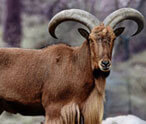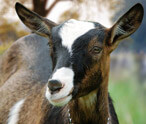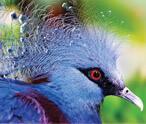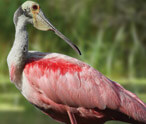Giraffe and its Diet
A giraffe, also known as Giraffa camelopardalsi, is an innocent herbivore. It harms no animals and feeds peacefully on plant material. In the animal kingdom, it is popular as the tallest mammal. Its long neck extends to almost six feet and helps it reach out to the branches of trees easily. It eats leaves, buds, shoots as well as shrubs found in the savannahs and grasslands of eastern Africa. Its other sources of food may be fruits, roots, seedpods, twigs and even dry and spiky thorns. It also feeds on the leaves, fruits and shoots of apricot trees. This answers the question, what do giraffes eat. Unlike elephants, however, these tall and large mammals do not end up destroying vegetation as they feed.
In certain regions of its habitat, the salty soil is a rich source of minerals. In such areas, the Giraffa camelopardalis also feeds on the soil to fulfill its body's nutritional requirements.
Natural Adaptations for Feeding
After finding out what do giraffes eat, it is also interesting to discover how they feed. Nature has bestowed these mammals with certain adaptations which help them eat from tall trees and fulfill their need for energy and nutrients.
- With their long necks helping them to obtain food from tree tops, their amazingly long tongues can also extend up to 18 inches and help in reaching leaves and shoots at high levels.
- This tongue also helps in removing bugs from plant material before putting it in their mouths.
- Their long legs help them to walk at a favorably fast pace of 10 miles per hour. Therefore, they can walk around and reach long distances easily to find food.
- Giraffa camelopardalis is a ruminant. This means it consists of more than 1 stomachs four to be specific. Therefore, the digestion of food takes place properly.
- The sleeping requirement of the mammal is quite small. It only needs between 10 to 120 minutes of sleep. Therefore, it can spend the rest of the day for browsing.
- Their plant diet also fulfills their need for water. Often, the moisture found on leaves is sufficient to quench their thirst, helping them to go on living without drinking for many days at a stretch.
Ruminating System of Giraffa camelopardalis
As mentioned above, the animal is a ruminant. In fact, it is the largest of all ruminants. It possesses more than one stomach for better digestion of the plant matter that it feeds on. As it eats large amount of leaves, shoots and twigs, it consumes high quantities of tough fiber and lignin. These are first broken down and softened in the first stomach and passed on to the next one for further softening. The process is repeated in the other stomachs till the time the food is digested properly through chemical breakdown and the nutrients are absorbed into the animal's blood stream.
Interesting Facts
Have a look at the giraffe facts concerning their diet and feeding habits which are truly fascinating.
- A giraffe spends a large part of the day feeding. In fact, during some part of the year, it spends as much as seventy five percent of the day in feeding activities.
- The diet of a female Giraffa camelopardalis consists of more nutrition as compared to what its male counterpart eats. The diet of the latter mostly consists of fiber and lignin in plants.
- Although the long necks of both the males and females can reach high up to pluck leaves from trees, the males can obtain plant material from even higher levels.
- When nursing, a mother giraffe avoids tannin rich plant material for the sake of the health of its calf.
- The favorite Acacia trees are benefited by their feeding. This is because they end up dispersing seeds around and lead to the growth of these trees in different parts of the region. Apart from this seed dispersal, the animal has also been observed by scientists to help in pollination.
- Ants found on Acacia trees prevent the animal from over-grazing. Therefore, the population of these trees remains well-balanced.
- During dry season, a giraffe spends more time in feeding as compared to the rainy season. This is because it has to travel long distances often in order to find quality vegetation.
- The animal feeds not only during the day, but also at night. Mostly, it browses by the moonlight. During the darker part of nights, its digestive system is busy in ruminating. This system is also active during the day when the animal is feeding.
- One giraffe eats as much as one hundred and forty pounds of leaves, twigs and other plant matter within twenty-four hours.
For the populations of Giraffa camelopardalis to come out of endangerment, humans should stop destroying the food sources found in their habitat.
Latest Mammals

Types Of Goats
Goat is a mammal that belongs... read more

Goat Facts
A domesticated form the wild goat of...read more

Giraffes Facts
Giraffes are creatures with extremely...read more
Latest Birds

Victoria Crowned Pigeon
With its name...read more

Information About Flamingos
Flamingos are...read more

Hoopoe Bird
Famous for its distinctive crown of...read more

Roseate Spoonbill
The beautiful Roseate Spoonbill...read more























Largest Birds of Prey in the World by Size and Weight
Also called raptors, the birds...
List of Birds That Fly in V Formation
Did you ever feast your eyes on the amazing phenomenon...
Birds of Prey List
A bird of prey is also known as a raptor or a hunter. It belongs to the group of...
Millipedes Vs Centipedes
Centipedes and millipedes are both arthropods from the group...
Difference Between Warm Blooded and Cold Blooded Animals
Every living organism...
Top 10 Extremely Dangerous Insects
The insects have been grouped in class 'insecta' of...
Sheep Vs Goat
The goat and the sheep are related to each other through the same family. They...
Animals with Blue-colored Blood
Humans and other vertebrates have red-colored blood running...
Birds, Mammals And Reptiles
Before coming to the question of common ancestry of birds...